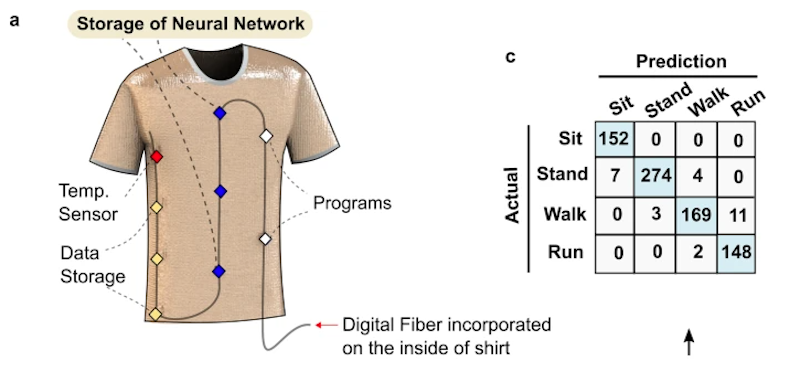[Yoel Fink] and his team at MIT have announced their creation of a fiber that can sense and store data. In addition, they can use data from a shirt made of the material to infer the wearer’s activity with high accuracy. The fiber contains hundreds of microscale silicon chips into a preform used to create a polymer fiber that connects the chips using four 25 micron tungsten wires. You can read the paper directly in Nature Communications.
The fiber contains temperature sensors and enough memory (24CW1280X chips) to store a short movie for two months without power. It also contains 1,650 neural network elements, which means the fiber can train to infer activity itself without additional help.
This sounds imaginative, but perhaps not yet practical. Right now, the fiber can survive being washed at least ten times and requires an external device and — presumably — external power. However, perhaps it is a glimpse of things to come.
Even if you aren’t interested in wearables, the creating of an ultra-tiny serial bus is interesting. It is also interesting to note that they use CNC milling to form the preform with the wire channels and other necessary features. We doubt too many Hackaday readers will want to try producing something like this, but we could see a lot of people wanting to purchase it and use it for different wearable projects.
We wonder if, one day, your clothes will have something like this in them for control and muscle fabric to allow them to reconfigure themselves. If sewing isn’t your bag, you might try 3D printing your electronic enclosures on your clothes.
















AI/ML Clothing = Creepy.
There are plenty of positive possible uses, I guess it depends on who is collecting the data and what they are doing with it.
The world will never be ready to use this technology responsibly. Let’s just hope cost keeps it out of reach.
Some day your Memory Foam mattress won’t be able to keep your secrets…. and your sheets will be tell on you….
We already have “Pillow talk”.
B^)
What’s the justification of putting fragile electronics in a harsh environment ? It sounds like a lousy solution looking for a small problem.
Maybe trying to discover how to make sturdier electronics?
What’s next? Pants that detect lies?
Perhaps by catching fire?
*Laughs in ESD shocks*
There *might* (keyword might) be some useful medical applications for AI/ML on the edge for diagnosing various chronic problems that can be picked up by posture/etc/etc but none that would really need to be sewn in like this. Otherwise still very creepy and feels like a weird project looking for a solution.
Otherwise I forsee that these chips will die a quick death from rubbing clothing on a human body rendering in alot of ESD damage.
Sounds like the sort of technology application that is only viable for projects of a nature where the funding is huge and they don’t mind burning through very expensive gear to achieve the mission.